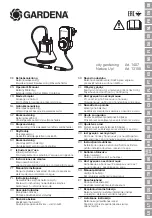
ECE 488: RF Circuits and Systems Spring 2005
CORNELL UNIVERSITY © WES SWARTZ (03/8/2)
1
The Tektronix TDS 220 Oscilloscope
A Very Brief Introduction
A Tektronix TDS 220 two-channel digital oscilloscope (“scope” or “Oscope” for short) is
pictured below with its controls grouped for easy recognition in the discussion that
follows.
Figure 1: Front panel of a Tektronix TDS 220 oscilloscope.
1. Oscilloscope
display
The LCD display replaces the cathode-ray tube used in older oscilloscopes. It adds
digital readouts of various settings and menu options. The example shown here displays
only Channel-1 on a voltage scale of 2 Volts per division (as indicated by
CH1 2.00V
in
the bottom-left corner of the display). The digit “1” with the arrow along the left edge
indicates the zero base line for the voltage of Channel 1. The time scale is set at
250 ns
(250 nano-seconds or 2.5
X
10
-7
seconds) per division. Since there are 10 divisions from
left to right, the display shows a total time of 2.5 µs (2.5 micro-seconds). The downward
pointing arrow at the middle of the screen’s top edge indicates when triggering of the
display occurred (on a rising edge of the square wave). The leftward-pointing arrow
along the right side of the display indicates the voltage threshold that will trigger a sweep
of the trace. The items down the right side of the display indicate the functions of the
side-screen menu buttons for the particular menu (
CH1
) currently selected. This
























